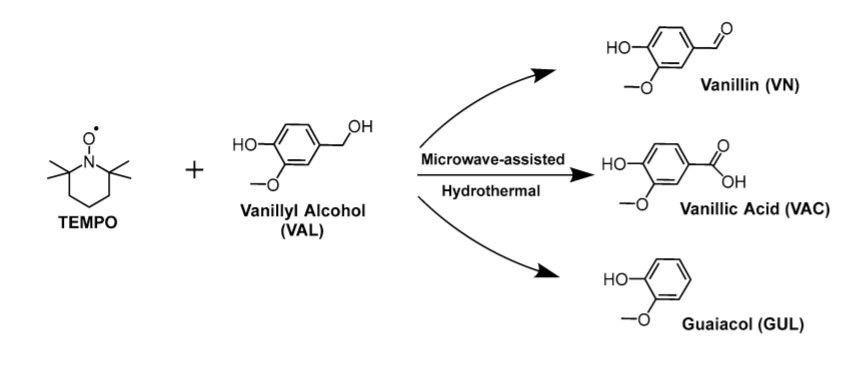| 論文篇名 | 英文:Microwave-Assisted Catalyst-Free Oxidative Conversion of a Lignin Model Compound to Value-Added Products Using TEMPO 中文:使用TEMPO的木質素模型化合物的微波輔助無催化劑氧化轉化為增值產品 |
| 期刊名稱 | Waste and Biomass Valorization |
| 發表年份,卷數,起迄頁數 | 2019 |
| 作者 | Jia-Yin Lin Jechan Lee Kun-Yi Andrew Lin |
| DOI | 10.1007/s12649-019-00646-5 |
| 中文摘要 | 由於香草醇(VAL)的氧化轉化為香草醛(VN)表示木質素化合物的增值重要過程,因此2,2,6,6-四甲基哌啶-1-氧基(TEMPO)首次用於使用微波輻射(MWI)在不存在催化劑的情況下氧化VAL。與過氧化氫,過硫酸鹽和過硫酸一硫酸鹽相比,TEMPO導致香蘭素(SVN)的選擇性和VN的產率顯著提高。此外,MWI在將VAL轉換為具有更高SVN的VN方面比常規水熱工藝更有效。較長的反應時間對於使用SVN和VN收率更高的MWI通過TEMPO將VAL轉化為VN非常有利。此外,在較高的溫度下使用較高的TEMPO劑量,使用MWI進行TEMPO氧化VAL所得的SVN和VN的收率也可以得到顯著提高。通過TEMPO使用MWI將VAL轉化為VN的最佳條件是在160°C下使用1.5 g TEMPO進行7.5 min MWI,VN的最高產率為17%,SVN為99%,高於許多報導催化劑過程的價值。 TEMPO也可以重新用於氧化VAL以生成VN,並具有相當穩定的VN和SVN收率。這些結果表明,即使沒有催化劑,TEMPO也可以成功有效地將VAL轉化為增值的酚醛產品,例如VN。這項研究的結果可用於進一步研究TEMPO介導的木質素化合物的氧化。 |
| 英文摘要 | As oxidative conversion of vanillyl alcohol (VAL) to vanillin (VN) represents an important process for valorization of lignin compounds, 2,2,6,6-tetramethylpiperidine-1-oxyl (TEMPO) is employed for the first time as an oxidant to oxidize VAL in the absence of catalysts using microwave irradiation (MWI). In comparison with H2O2, persulfate and peroxymonosulfate, TEMPO leads to the significantly higher selectivity of vanillin (SVN) and yield of VN. In addition, MWI is also more effective than conventional hydrothermal process for converting VAL to VN with a much higher SVN. A longer reaction time is highly favorable for VAL conversion to VN by TEMPO using MWI with a much higher SVN and yield of VN. Besides, the SVN and yield of VN from VAL oxidation by TEMPO using MWI could be also significantly improved at the elevated temperature with a higher TEMPO dosage. The optimal condition for VAL conversion to VN by TEMPO using MWI is the usage of 1.5 g of TEMPO for 7.5 min of MWI at 160 °C and the highest yield of VN is 17% with SVN of 99%, which is higher than many reported values of catalyst-involved processes. TEMPO can be also re-used to oxidize VAL to generate VN with quite stable yield of VN and SVN. These results indicate that TEMPO, even without catalysts, can successfully and effectively convert VAL to the value-added phenolic products, such as VN. The findings of this study can be useful for further investigating TEMPO-mediated oxidation of lignin compounds. |
Microwave-Assisted Catalyst-Free Oxidative Conversion of a Lignin Model Compound to Value-Added Products Using TEMPO 2019-03-11

循環農業:農業廢棄物高價值化【環工系林坤儀教授】






